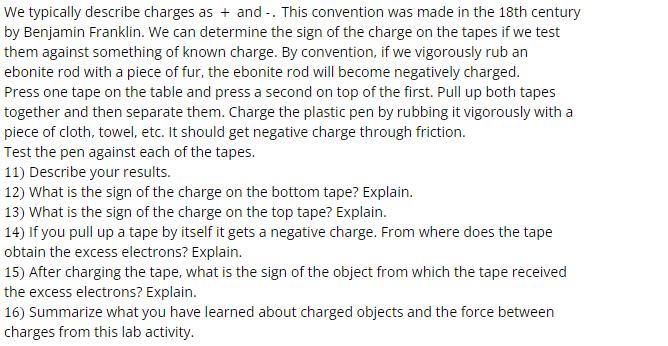Answered step by step
Verified Expert Solution
Question
1 Approved Answer
We typically describe charges as + and -. This convention was made in the 18th century by Benjamin Franklin. We can determine the sign

We typically describe charges as + and -. This convention was made in the 18th century by Benjamin Franklin. We can determine the sign of the charge on the tapes if we test them against something of known charge. By convention, if we vigorously rub an ebonite rod with a piece of fur, the ebonite rod will become negatively charged. Press one tape on the table and press a second on top of the first. Pull up both tapes together and then separate them. Charge the plastic pen by rubbing it vigorously with a piece of cloth, towel, etc. It should get negative charge through friction. Test the pen against each of the tapes. 11) Describe your results. 12) What is the sign of the charge on the bottom tape? Explain. 13) What is the sign of the charge on the top tape? Explain. 14) If you pull up a tape by itself it gets a negative charge. From where does the tape obtain the excess electrons? Explain. 15) After charging the tape, what is the sign of the object from which the tape received the excess electrons? Explain. 16) Summarize what you have learned about charged objects and the force between charges from this lab activity.
Step by Step Solution
There are 3 Steps involved in it
Step: 1
11 The results of the experiment would be as follows When the negatively charged plastic pen is tested against the bottom tape they would attract each ...
Get Instant Access to Expert-Tailored Solutions
See step-by-step solutions with expert insights and AI powered tools for academic success
Step: 2

Step: 3

Ace Your Homework with AI
Get the answers you need in no time with our AI-driven, step-by-step assistance
Get Started


